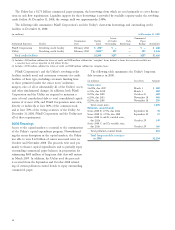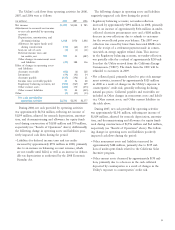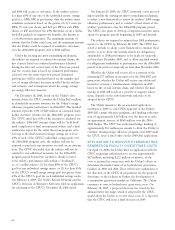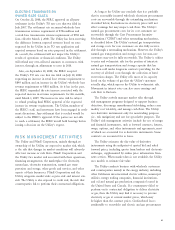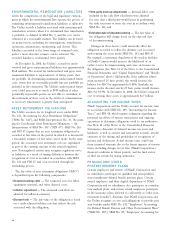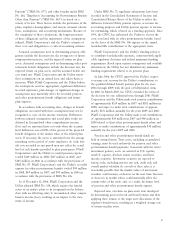PG&E 2008 Annual Report Download - page 60
Download and view the complete annual report
Please find page 60 of the 2008 PG&E annual report below. You can navigate through the pages in the report by either clicking on the pages listed below, or by using the keyword search tool below to find specific information within the annual report.58
Legislature also is considering legislation to increase the
RPS to require 33% of a retail seller’s electric load to be
met with renewable resources by 2020.
Following several RFOs and bilateral negotiations, the
Utility entered into various agreements to purchase renewable
generation to be produced by facilities proposed to be devel-
oped by third parties. The development of these renewable
generation facilities is subject to many risks, including risks
related to permitting, fi nancing, technology, fuel supply, envi-
ronmental, and the construction of suffi cient transmission
capacity. The Utility has been supporting the development
of these renewable resources by working with regulatory
and governmental agencies to ensure timely construction of
transmission lines and permitting of proposed project sites.
In addition, to help meet the challenging RPS goal by
2010, the Utility intends to explore developing and/or
owning renewable generation resources, subject to CPUC
approval. In particular, on February 24, 2009, the Utility
requested the CPUC to approve the Utility’s proposed
development of renewable generation resources based on
solar photovoltaic (“PV”) technology. The Utility’s proposal
includes the development and construction of up to 250 MW
of Utility-owned PV generating facilities, to be deployed
over a period of fi ve years, at an estimated capital cost
of approximately $1.5 billion, and the execution of power
purchase agreements for up to 250 MW of PV projects to
be developed by independent power producers.
OFF-BALANCE SHEET
ARRANGEMENTS
PG&E Corporation and the Utility do not have any off-
balance sheet arrangements that have had, or are reasonably
likely to have, a current or future material effect on their
fi nancial condition, changes in fi nancial condition, revenues
or expenses, results of operations, liquidity, capital expendi-
tures, or capital resources.
CONTINGENCIES
PG&E Corporation and the Utility have signifi cant
contingencies, including: tax matters, Chapter 11 disputed
claims, and environmental matters, which are discussed
in Notes 10, 15, and 17 of the Notes to the Consolidated
Financial Statements.
PROPOSED NEW GENERATION FACILITIES
Request for Long-Term Generation Resources
The Utility’s CPUC-approved long-term electricity procure-
ment plan, covering 2007-2016, forecasts that the Utility
will need to obtain an additional 800 to 1,200 MW of new
generation resources by 2015 above the Utility’s planned
additions of renewable resources, energy effi ciency, demand
reduction programs, and previously approved contracts for
new generation resources. The CPUC allows the California
investor-owned utilities to acquire ownership of new conven-
tional generation resources only through purchase and sale
agreements (“PSAs”) (i.e., a PSA is a “turnkey” arrangement
in which a new generating facility is constructed by a third
party and then sold to the Utility upon satisfaction of
certain contractual requirements) and engineering, procure-
ment, and construction arrangements proposed by third
parties. The utilities are prohibited from submitting offers
for utility-built generation in their respective requests for
offers (“RFOs”) until questions can be resolved about how
to compare utility-owned generation offers with offers from
independent power producers. The utilities are permitted to
propose utility-owned generation projects through a separate
application outside of the RFO process in the following
circumstances: (1) to mitigate market power demonstrated
by the utility to be held by others, (2) to support a use
of preferred resources, such as renewable energy sources,
(3) to take advantage of a unique and fl eeting opportunity
(such as a bankruptcy settlement), and (4) to meet unique
reliability needs.
On July 21, 2008, the Utility received offers from third
parties in response to the Utility’s April 1, 2008 RFO for
800 MW to 1,200 MW of dispatchable and operationally
fl exible new generation resources to be on-line no later than
May 2015. The Utility’s RFO requested offers for both PSAs
and power purchase. In the fourth quarter of 2008, the
Utility developed its RFO shortlist of participants and is
currently involved in negotiations with potential counter-
parties. The Utility anticipates executing contracts and
requesting CPUC approval of the executed contracts in
the fi rst half of 2009.
Proposed Renewable Energy Development
California law establishes a renewable portfolio standard
(“RPS”) that requires that each California retail seller of
electricity, except for municipal utilities, increase its pur-
chases of renewable energy (such as biomass, small hydro-
electric, wind, solar, and geothermal energy) by at least 1%
of its retail sales per year, so that the amount of electricity
delivered from renewable resources equals at least 20%
of its total retail sales by the end of 2010. The California


